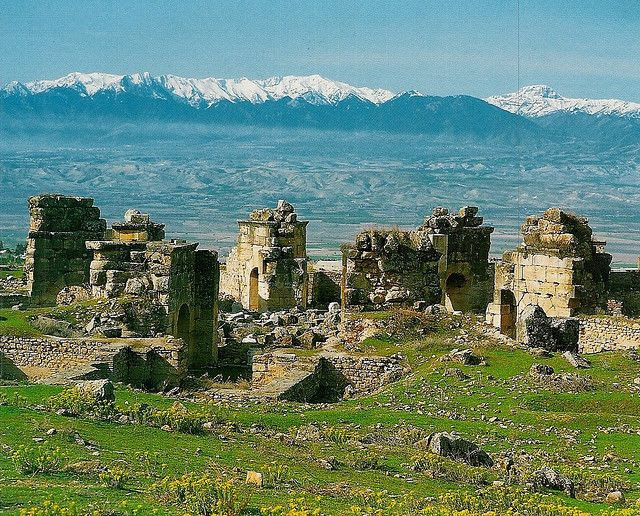| Acts 8: 26 – 40 The extraordinary octagonal Martyrium of St. Philip the Apostle at Hierapolis is built on the site where it is believed, with considerable credibility, that St. Philip was martyred. The arches of the eight individual chapels there, marked by crosses, originally had heptagonal interiors. It is a remarkable archaeological location. I first went to Pamukkale in Western Turkey, about a three hour drive from Kusadasi, to wander through the terraced hot-springs that spill down the mountainside like cotton candy. It was only after arrival that I realized Pamukkale was on the doorstep of ancient Hieropolis, with its extensive and interesting necropolis filled with sarcophagi. I have a thing for graveyards, so I set off on a hike, got thoroughly lost, and stumbled on the Martyrium as the sun dipped and illuminated the ruins in rose-colored light. I later learned the Martyrium is quite famous and, though difficult to access, frequently visited. I think it charmed me in part because it was, for me, an accidental discovery, and whenever I returned to that part of Turkey, I hiked to see the Martyrium of St. Philip. I’ve been fascinated by the Apostle Philip ever since. This story in the eighth chapter of the Book of Acts certainly quickens the imagination. Philip sets out on the wilderness road from Jerusalem to Gaza, prompted by the Spirit. That must have been some prompt. This is vacant and uninviting terrain. A high-official from the court of the Candace, the Ethiopian regent, is returning from Jerusalem where he had gone to worship. He is said to have been a eunuch, and as a castrated man would not have been permitted into the Jerusalem Temple, whatever his political station in Ethiopia (Deuteronomy 23:1). Perhaps then, this ‘Theophilus,’ this seeker and lover of God, is frustrated and annoyed. Jerusalem is a long haul from Ethiopia only to arrive and find bouncers at the Temple door. Philip, prompted once more, runs beside the chariot of the high official and is invited aboard for the ride. The Ethiopian is reading from the Book of Isaiah, and Philip interprets to him what he is reading, because Scripture is always, for good and ill, interpreted. Having proclaimed the Gospel, the Ethiopian eunuch requests baptism, and water is somehow found in the desert. Philip is whisked away to Azotus (modern Esdud) and the official in the Court of the Candace continues home. The Coptic Christians of Ethiopia form an ancient strand of Christianity with magnificent churches carved into rock and mountain. The Copts are one of five Christian sects with rights in the Church of the Holy Sepulchre in Jerusalem, along with Armenian Orthodox, Assyrian Orthodox, Greek Orthodox, and Roman Catholics. Did the Ethiopian eunuch spiritually seed his home country for Christ? We might be made to muse by this tale. We do know that the conversion of the Ethiopian occurs in the Book of Acts between the conversion of the Samaritans and the conversion of a Greek. The Gospel is unhindered by race, cast or geography, and a new thing is unfolding in God’s wide world. Grace and peace, The Reverend Canon George F. Woodward III For those who Influence Public Opinion “Almighty God, you proclaim your truth in every age by many voices: Direct, in our time, we pray, those who speak where many listen and write what many read; that they may do their part in making the heart of this people wise, its mind sound, and its will righteous; to the honor of Jesus Christ our Lord. Amen.” The Book of Common Prayer page 827 Previous Reflections may be found on the parish website StPaulSMA.com under ‘Blogs’ here. YouTube postings are available here. Previous editions of THE EPISTLE can be found here. |

| St. Paul’s Anglican Church Calzada del Cardo, 6 Centro 37700, San Miguel de Allende, Mexico 415.121.3424 www.StPaulSMA.com |

